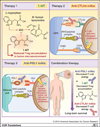Blocking immunosuppressive checkpoints for glioma therapy: the more the Merrier!
- PMID: 24879798
- PMCID: PMC4330468
- DOI: 10.1158/1078-0432.CCR-14-0820
Blocking immunosuppressive checkpoints for glioma therapy: the more the Merrier!
Abstract
Immunosuppressive checkpoints mediated by IDO, CTLA4, and PD1/PDL1 play a critical role in glioma progression and the efficacy of immunotherapies. Combined blockade of these immunosuppressive checkpoints in a glioma model elicited long-term survival. This combined blockade adds to the armamentarium of anti-glioma therapies, which could be implemented in clinical trials. Clin Cancer Res; 20(20); 5147-9. ©2014 AACR.
©2014 American Association for Cancer Research.
Conflict of interest statement
No potential conflicts of interest were disclosed.
Figures

Comment on
-
Durable therapeutic efficacy utilizing combinatorial blockade against IDO, CTLA-4, and PD-L1 in mice with brain tumors.Clin Cancer Res. 2014 Oct 15;20(20):5290-301. doi: 10.1158/1078-0432.CCR-14-0514. Epub 2014 Apr 1. Clin Cancer Res. 2014. PMID: 24691018 Free PMC article.
Similar articles
-
Durable therapeutic efficacy utilizing combinatorial blockade against IDO, CTLA-4, and PD-L1 in mice with brain tumors.Clin Cancer Res. 2014 Oct 15;20(20):5290-301. doi: 10.1158/1078-0432.CCR-14-0514. Epub 2014 Apr 1. Clin Cancer Res. 2014. PMID: 24691018 Free PMC article.
-
Characterization of the Selective Indoleamine 2,3-Dioxygenase-1 (IDO1) Catalytic Inhibitor EOS200271/PF-06840003 Supports IDO1 as a Critical Resistance Mechanism to PD-(L)1 Blockade Therapy.Mol Cancer Ther. 2018 Dec;17(12):2530-2542. doi: 10.1158/1535-7163.MCT-17-1104. Epub 2018 Sep 19. Mol Cancer Ther. 2018. PMID: 30232146
-
Indoleamine 2,3-dioxygenase is a critical resistance mechanism in antitumor T cell immunotherapy targeting CTLA-4.J Exp Med. 2013 Jul 1;210(7):1389-402. doi: 10.1084/jem.20130066. Epub 2013 Jun 10. J Exp Med. 2013. PMID: 23752227 Free PMC article.
-
Targeting immune checkpoints in malignant glioma.Oncotarget. 2017 Jan 24;8(4):7157-7174. doi: 10.18632/oncotarget.12702. Oncotarget. 2017. PMID: 27756892 Free PMC article. Review.
-
Progress of immune checkpoint therapy in the clinic (Review).Oncol Rep. 2019 Jan;41(1):3-14. doi: 10.3892/or.2018.6819. Epub 2018 Oct 24. Oncol Rep. 2019. PMID: 30365127 Review.
Cited by
-
Cancer Stem Cells and Immunosuppressive Microenvironment in Glioma.Front Immunol. 2018 Dec 21;9:2924. doi: 10.3389/fimmu.2018.02924. eCollection 2018. Front Immunol. 2018. PMID: 30619286 Free PMC article. Review.
-
Overcoming immune evasion with innovative multi-target approaches for glioblastoma.Front Immunol. 2025 Jan 22;16:1541467. doi: 10.3389/fimmu.2025.1541467. eCollection 2025. Front Immunol. 2025. PMID: 39911397 Free PMC article. Review.
-
Recent advances and future of immunotherapy for glioblastoma.Expert Opin Biol Ther. 2016 Oct;16(10):1245-64. doi: 10.1080/14712598.2016.1212012. Epub 2016 Jul 27. Expert Opin Biol Ther. 2016. PMID: 27411023 Free PMC article. Review.
-
Novel anti-melanoma treatment: focus on immunotherapy.Chin J Cancer. 2014 Sep;33(9):458-65. doi: 10.5732/cjc.014.10118. Chin J Cancer. 2014. PMID: 25189718 Free PMC article.
-
Focused ultrasound-aided immunomodulation in glioblastoma multiforme: a therapeutic concept.J Ther Ultrasound. 2016 Jan 22;4:2. doi: 10.1186/s40349-016-0046-y. eCollection 2016. J Ther Ultrasound. 2016. PMID: 26807257 Free PMC article. Review.
References
Publication types
MeSH terms
Substances
Grants and funding
- R01-NS054193/NS/NINDS NIH HHS/United States
- R01-NS061107/NS/NINDS NIH HHS/United States
- R01 NS082311/NS/NINDS NIH HHS/United States
- R01 NS074387/NS/NINDS NIH HHS/United States
- U01 NS052465/NS/NINDS NIH HHS/United States
- R01 NS061107/NS/NINDS NIH HHS/United States
- R21 NS084275/NS/NINDS NIH HHS/United States
- R01-NS057711/NS/NINDS NIH HHS/United States
- R01 NS057711/NS/NINDS NIH HHS/United States
- R01-NS074387/NS/NINDS NIH HHS/United States
- R21-NS084275/NS/NINDS NIH HHS/United States
- R01 NS054193/NS/NINDS NIH HHS/United States
- U01-NS052465-S1/NS/NINDS NIH HHS/United States
- R01-NS082311/NS/NINDS NIH HHS/United States
LinkOut - more resources
Full Text Sources
Other Literature Sources
Medical
Research Materials

